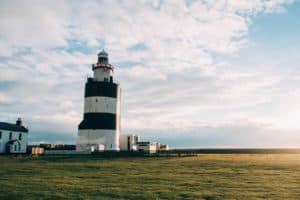The Sidhe: Guardians of the Mounds or Ancient Deities? Unveiling Celtic Mysteries
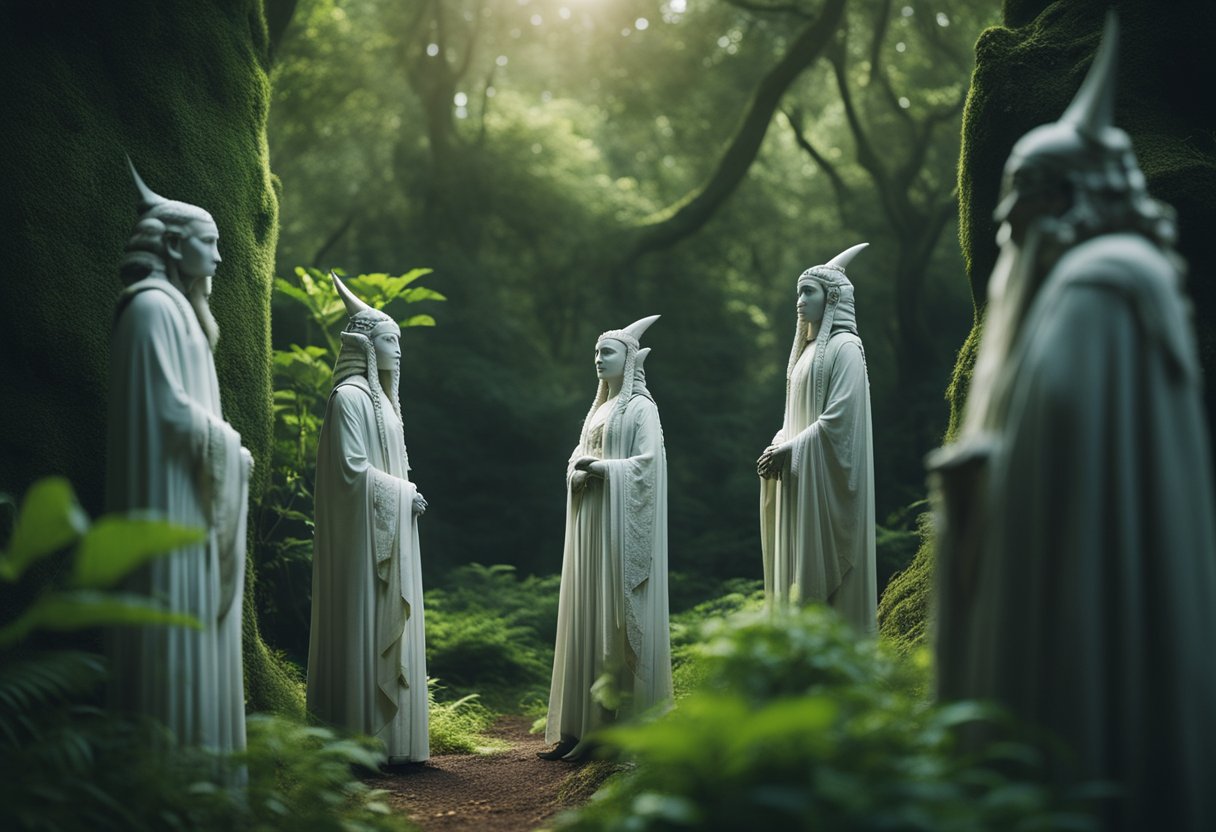
Updated On: March 17, 2024 by Eman Sameh
In exploring the enigmatic nature of the Sidhe, one must consider the rich tapestry of Irish folklore that paints these entities as both guardians of the mounds and possible deities in their own right. Irish mythology abounds with tales of the Sidhe, often described as supernatural beings living in a parallel realm that coexists with our own. These beings, whose name is derived from the Gaelic term for ‘mounds’, are thought to reside in the otherworldly portals found within the Irish landscape’s hills and burial sites.

The Sidhe are intricately woven into the natural and spiritual fabric of Ireland, having been venerated and feared by generations. Their lasting presence in Irish culture suggests a deep-seated belief in the existence of a mystical dimension that lies just beyond human perception. Although the Sidhe are commonly associated with the ancient mounds thought to be entrances to their world, their role within Irish lore extends to a broader conceptualisation of life, death, and the inscrutable nature of existence itself.
The Mythological Origins of the Sidhe
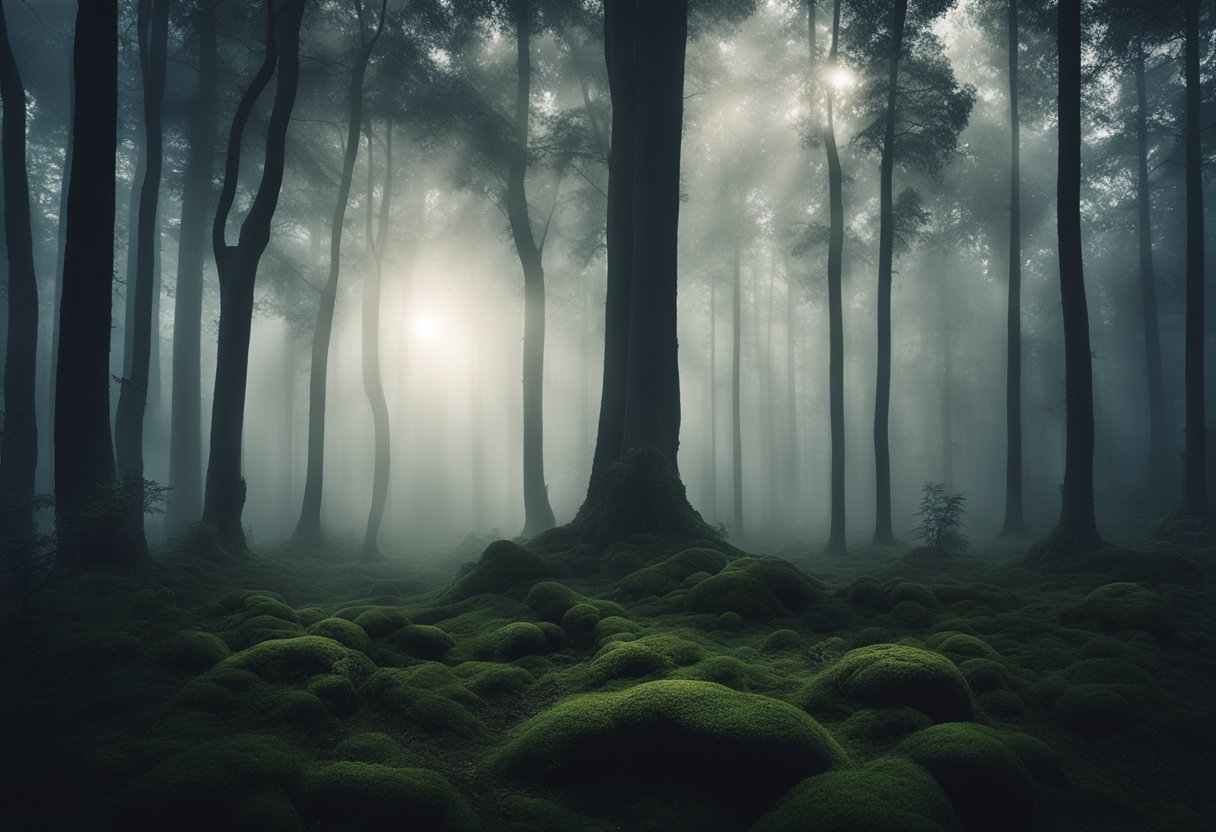
Since time immemorial, the Sidhe have been intertwined with the lore of the Emerald Isle, captivating those who seek the whispers of Ireland’s past. Their origins are steeped in the annals of the Tuatha Dé Danann and the Aos Sí, framed by the poetic verses of the Lebor Gabála Érenn. These spectral figures embody the essence of Irish mythology, where gods and goddesses play an integral role in the shaping of ancient sagas.
Tuatha Dé Danann and the Aos Sí
The Tuatha Dé Danann, often associated with the pantheon of Irish gods and goddesses, are believed to be the precursors of the Aos Sí – the fair folk. According to lore, when the Tuatha Dé Danann were defeated, they retreated into the Otherworld, becoming the elusive Aos Sí who watch over Old Irish fairy mounds and hills. It is within these mounds, or Sidhe that they found sanctuary, and from there, they were said to emerge and interact with the mortal world, albeit rarely and with great caution.
The Lebor Gabála Érenn and Irish Mythological Cycle
The Lebor Gabála Érenn, commonly referred to as the Book of Invasions, chronicles the legendary origins and lineage of the Irish people, including the arrival of the Tuatha Dé Danann. It forms a core part of the Irish Mythological Cycle, a series of narratives that also contains the exploits and tales of these ancient deities. The Lebor Gabála Érenn serves not only as a piece of mythology but as a framework through which the Sidhe’s ancient existence is traced back to a time when the line between the gods and the earth was ever so thin.
Cultural Depictions of the Sidhe in Ireland
Throughout Ireland’s cultural landscape, the Sidhe occupy a prominent place, manifested vividly in literary works and the evolving perceptions of Irish mythology.
Literary References and Folk Narratives
The Sidhe, or Aos Sí, as they are known in the Irish language, possess a rich presence in Ireland’s literary and oral traditions. They are often depicted in folk narratives as the remnants of ancient gods, sovereign over the many fairy mounds that dot the countryside. Their stories permeate Irish lore, with texts often referencing the Bean Sídhe or banshee, whose mournful wail is a premonition of death. It’s in the lyricism of Irish folklore that we find characters like the mischievous leprechaun and the noble gentry of the Sidhe, each embodying a facet of Ireland’s multi-layered mythic tapestry.
From Gods to Fairies: The Evolution of the Sidhe
Initially revered as deities, the Sidhe’s depiction in Irish culture shifted with the advent of Christianity, transforming these once godly figures into the realms of the fairies and elves we recognise today. This transformation is evident in both literature and the common discourse we encounter across Ireland. They embody a bridge between the seen and unseen world, their every mention evoking the mystique of Ireland’s mythic past. From this evolution, the Sidhe have endured in the cultural imagination, not only as guardians of ancient sites but also as enduring symbols of the enchantment that Ireland’s history holds.
Guardians of the Mounds
The Sidhe are intricately linked to the various mounds that scatter the Irish landscape, from fairy hills to burial mounds; these sites are steeped in lore and believed to be the abodes of these otherworldly beings.
Sacred Mounds and Burial Sites
Fairy forts and hollow hills dotting the land are not merely natural features; they’re considered sacred. The ancestors are thought to be interred beneath these mounds, the rath and burial mound serving as portals to a bygone era. These ancient structures are held in reverence and believed to be the dwelling places of the Sidhe.
Guardianship and the Supernatural Connection
Guardianship over these mounds is attributed to the Sidhe, who are seen as the protectors of these mystical sites. The connection between the Sidhe and the mounds extends beyond mere guardianship—it’s believed to be supernatural, tying the physical terrain to the Otherworld. Fairy hills become not only markers of Irish heritage but gateways to an enchanted realm where the Sidhe reigns supreme.
Rituals and Offerings: Human Interactions with the Sidhe
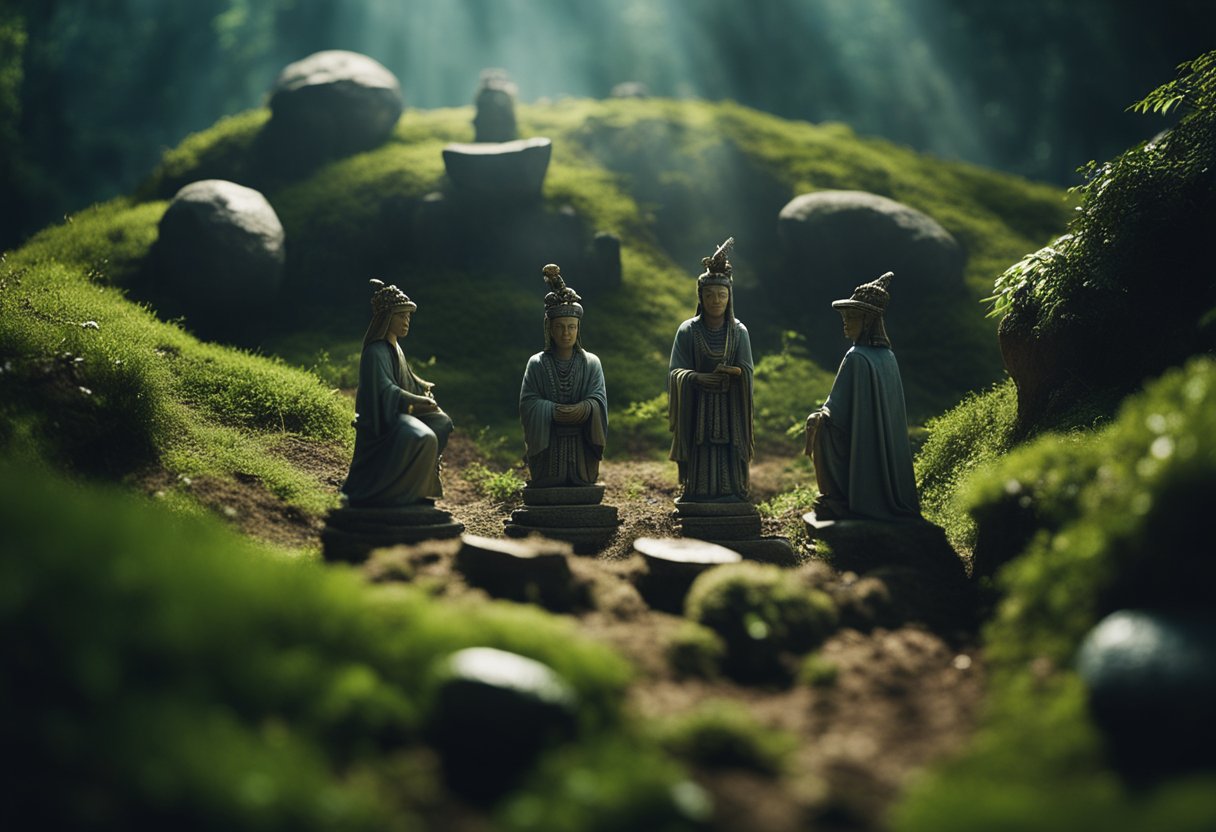
In our exploration of Irish folklore, the rituals and offerings made to the Sidhe encapsulate a blend of respect and superstition that has permeated Irish culture for centuries. These practices are deeply ingrained in the seasonal festivals punctuating the Irish calendar and reveal the human desire to coexist harmoniously with these mystical beings.
Seasonal Festivals and Offerings
Samhain, the precursor to modern Halloween, is arguably the most significant time for honouring the Sidhe. It is believed that during Samhain, the veil between our world and that of the Sidhe is at its thinnest. Offerings of food and drink are traditionally left out to appease these spirits. In the past, it was hoped that such offerings would ensure the Sidhe’s favour or at least deter them from causing mischief.
Bealtaine, the festival welcoming summer, is another pivotal event. Bonfires are lit to celebrate the light, and some tales suggest that these fires also protect us from the Sidhe, who might be particularly active during this time. At Midsummer, rituals include the creation of protective wreaths and, again, making offerings to these ancient deities, asking for their blessings on the longest day of the year.
Respect and Superstitions
Our respect for the Sidhe is intertwined with a deep-seated superstition. It is customary to avoid disturbing places believed to be their dwellings, such as hawthorn trees or fairy mounds, as this could bring bad fortune. Even today, many in Ireland will tell you about the importance of maintaining this respect, demonstrating the enduring influence of these beliefs.
The customs surrounding the Sidhe are not mere folk practices; they are a testament to our enduring connection with Ireland’s ancient spirituality and a recognition of the power ascribed to these invisible yet ever-present entities in Irish lore.
The Sidhe Within the Natural World
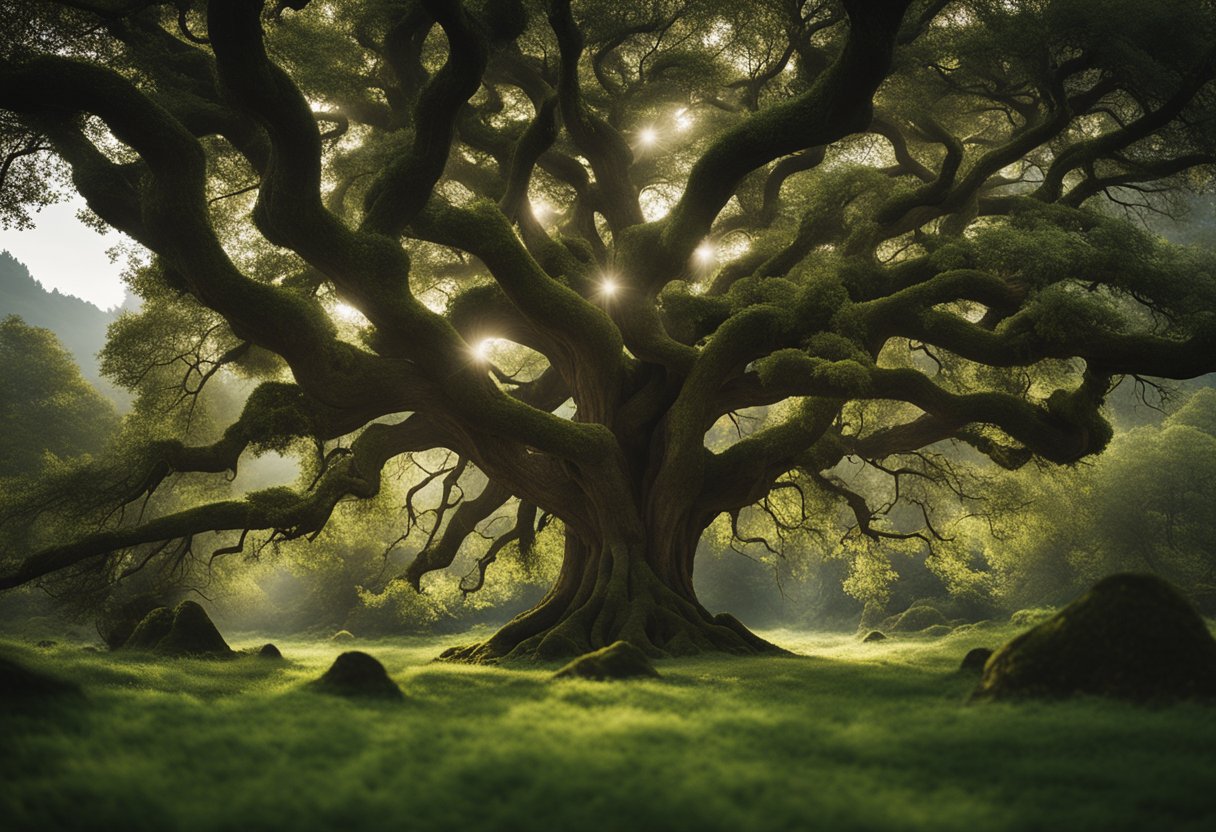
In exploring the natural world of the Celtic landscapes, the Sidhe are often envisioned as the ever-present guardians of the environment, intertwining with various elements and living beings.
Landscape and Elemental Associations
In the Celtic nations, the Sidhe are traditionally associated with distinctive natural features, especially woodlands and mounds, commonly known as fairy hills. Woodlands are thought to be places of power, where the Sidhe might appear, sometimes amidst ancient trees considered to dwell with spirits. In Ireland and Scotland, the concept of fairy hills or fairy forts is widespread; these mounds are respected as gateways to the otherworldly realms of the Sidhe. Within the lakes and lochs, another layer of association appears, as water is often considered an elemental gateway to the worlds below, with the Sidhe either inhabiting these depths or using them to travel between realms.
Flora, Fauna, and the Fairy Realms
The Sidhe’s connection with the natural world extends into the realm of flora and fauna. Stories abound of the Good People having deep relationships with certain plants, which might be either protections from their mischief or tokens of their favour. The Sidhe are traditionally said to protect animals found within their domains, especially those woods and waterways aligned with their presence. It is within these realms that dreams and legends intertwine, leading many to believe that interactions with the Sidhe could occur within the dream world — a space where the constraints of the tangible realms no longer apply.
The Otherworld: Concept of an Invisible Realm
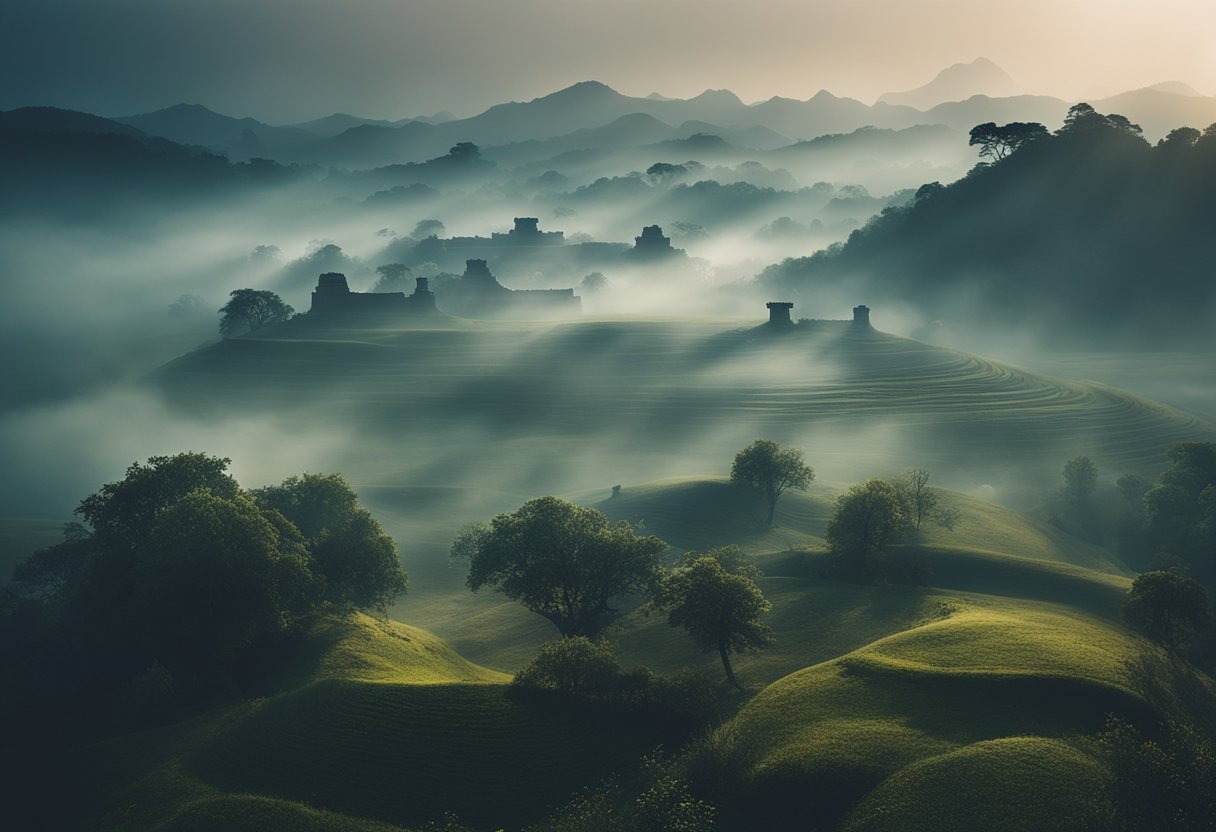
In exploring the enigmatic nature of the Celtic Otherworld, we unveil a realm that is both invisible and interlaced with our own. This dimension is not just a mythological abstract but a cornerstone of ancient Celtic beliefs – a domain of otherworldly beings, fairy hosts, and ethereal palaces that exist parallel to the physical world.
Portals to the Otherworld and Beyond
According to Celtic myth, the Otherworld is a spectral plane of existence that one might access through specific natural features in the landscape. Burial mounds and ancient hill forts, recognised as sídhe or fairy mounds, are believed to be gateways to this realm. These sites, suffused with the essence of the otherworldly air, are not mere resting places for the dead but portals to an underground domain where time flows differently, and the normal rules of the mortal world do not apply.
- Examples of Portals:
- Brú na Bóinne: A complex of Neolithic mounds in Ireland.
- Cnoc Meadha: Reputed as a residence of the fairy host in Irish myth.
Other natural formations, such as caves, lakes, and forests, are also considered thresholds to the Otherworld. These locations host entrances to the subterranean Otherworld, which is often envisioned as a system of palaces, each ruled by its sovereign.
Interactions Between the Mortal and the Fairy
Encounters between humans and the inhabitants of the Otherworld are a recurring theme in Celtic lore. These interactions are often unpredictable, ranging from friendly assistance to malevolent trickery. The aos sí or daoine sí, also known as the fairies or the sidhe, may manifest to mortals during particular times, such as the festival of Samhain, when the veil between worlds is thinnest.
- Forms of Interaction:
- Guidance: Fairy beings may guide or advise mortals.
- Abduction: Tales of humans taken to the fairy realm abound.
- Blessings and Curses: The sidhe holds the power to bestow both.
The tales serve as cautionary notes that respect and precautions are needed when dealing with these powerful entities that dwell in the invisible world alongside us.
The Sidhe in Modern Irish Culture
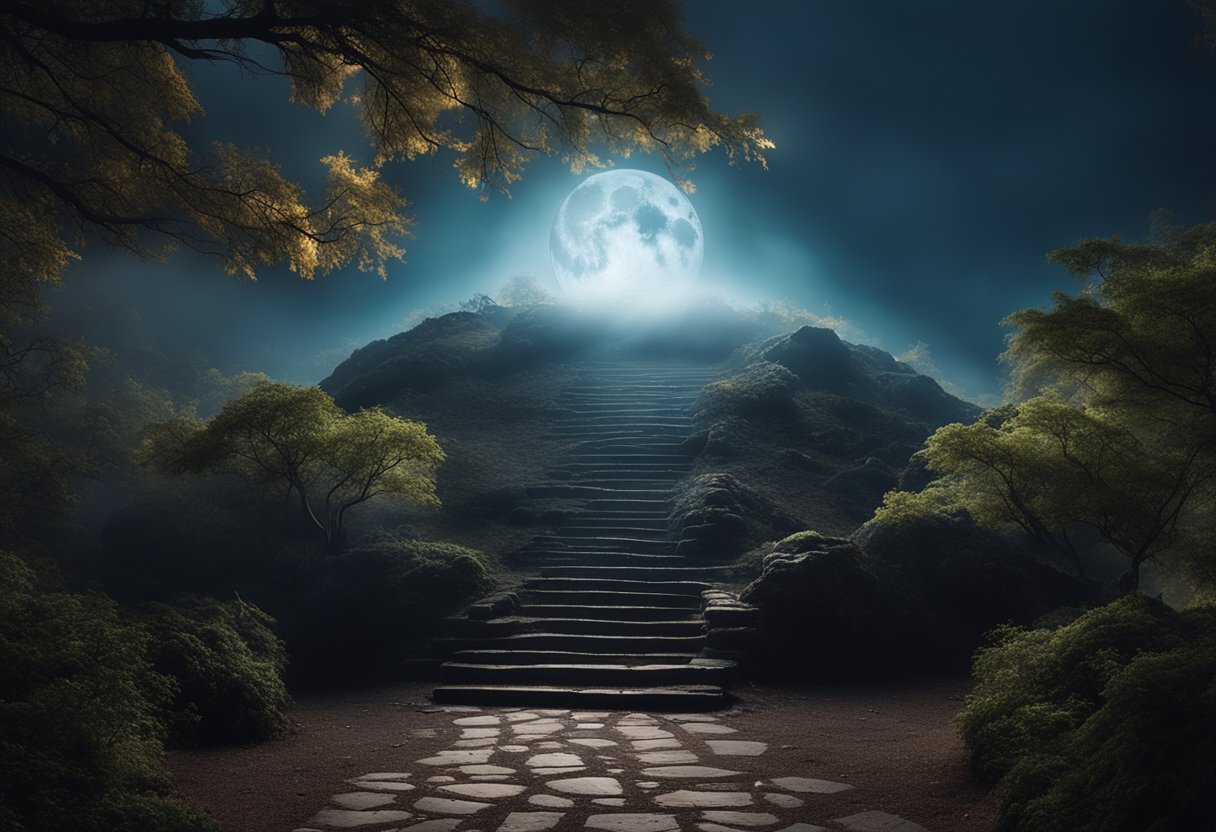
Contemporary Irish culture continues to reflect a fascination with the Sidhe, incorporating ancient beliefs into modern life and the arts. This enduring legacy reflects not only a connection to Ireland’s mythical past but also how these elements shape national identity.
Survival of Ancient Beliefs in Contemporary Ireland
In the fabric of modern Irish society, the presence of the Sidhe or the folk can be palpable. Despite the country’s advancements, many locals retain a belief in these otherworldly entities, often referred to as the good neighbours. This term illustrates a certain level of respect and caution when invoking their name directly. It’s not uncommon to hear anecdotes or to absorb unwritten rules that pay heed to these ancient spirits, an attestation to the survival of age-old folklore.
Life in rural areas particularly showcases a reverence for the Sidhe, where it’s considered prudent to avoid disrupting their reputed dwelling places, such as fairy mounds or rings. Actions such as building over a fairy path may attract misfortune, highlighting the Sidhe’s perceived hidden influence over the land.
Influence on Modern Arts and Storytelling
Irish literature, music, and dance thrive on narratives interwoven with tales of the Sidhe. The arts perpetuate and evolve these stories, sometimes exploring their darker or more mysterious nature. Authors and poets conjure up their images while musicians embed the tradition of the Sidhe into melodies that echo Ireland’s historical landscape.
In visual media, the portrayals vary from fantastical renditions in contemporary Irish cinema to subtle influences in popular television series. The Sidhe serve not only as muses but are often emblematic of Ireland’s spiritual undercurrents, moving seamlessly from the past into the pulse of current Irish creativity. This cultural interplay ensures that the Sidhe remains an intrinsic part of Ireland’s storytelling fabric as ancient deities or guardians of the mounds.
Legends and Tales: The Rich Tapestry of Sidhe Lore
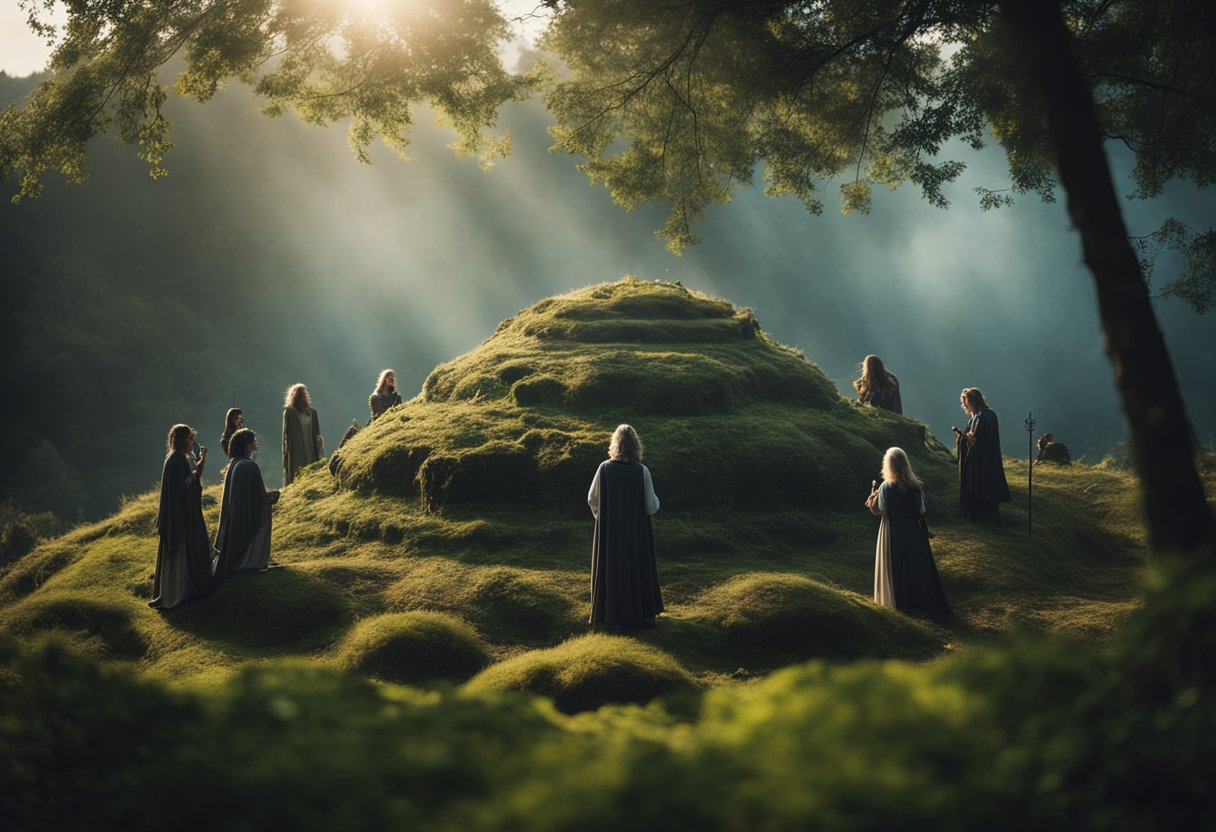
In Ireland’s verdant hills and misty vales, tales of the Sidhe have been woven into the fabric of the land’s mythology and history.
Haunting Banshees and Mischievous Leprechauns
Banshees, or bean sídhe as they are known in Irish, are foreboding omens whose mournful cries are believed to herald death. Their presence weaves a chilling thread through Irish folklore, portraying them as guardians of family lineage who call out when a clan member is to pass.
Leprechauns, however, hold a rather different place in Irish fairy folklore. These diminutive figures are famed for their tricks and their hidden pots of gold. Often dressed in green, these mischievous entities from the Daoine sìth populate many a local legend, with countless tales spun around their cunning and elusive nature.
Epic Sagas and Heroic Battles
Epic tales within the Book of Leinster tell of grand battles such as those fought by the Tuatha Dé Danann, a race of god-like beings with powers beyond mortal ken. In battles against invaders like the Milesians, this ancient tribe defended their domain with bravery and enchantment.
These sagas also recount the Tuatha Dé Danann’s eventual retreat into the Otherworld, becoming the fair folk, the clandestine guardians of Ireland’s mystical mounds and forts. Their stories, intricately linked with Ireland’s ancient past, continue to inspire and instil wonder in all who hear of their mighty deeds.
Engage with these legends at our core, as each one brings us closer to understanding the profound depths of Ireland’s cultural heritage.
Concepts of Afterlife and Immortality Among the Sidhe
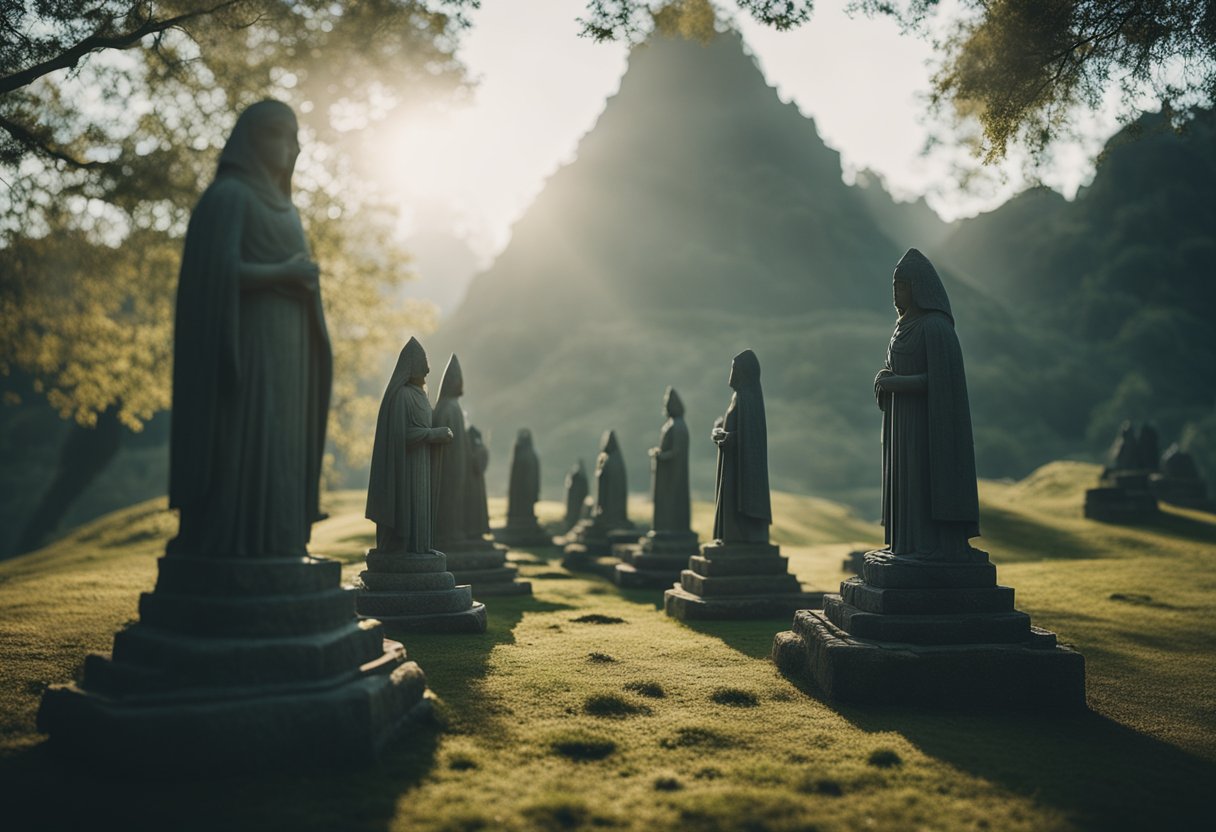
In our inquiry into the Sidhe’s beliefs, concepts of the afterlife and forms of immortality stand out as central to their mythology. These beings, often equated with the aes sídhe of Celtic tradition, possess a lore rich with connections to the otherworldly realms and ancestral veneration.
From Fallen Angels to Eternal Spirits
The Sidhe are perennial subjects of folklore that resonate with the idea of fallen angels cast out from heaven yet retaining aspects of their celestial origins. This narrative renders them as eternal spirits, dwelling within the mounds of Ireland’s landscapes—gateways to a land of inexhaustible youth and beauty. These entities embody the paradox of being at once divine and earthly; their ethereal existence is consistently marked by an immortality unique to the Irish mythos.
Connection with Ancestral Worship and Reverence
Our ancestors played a pivotal role in a tapestry of tales where the Sidhe are concerned. These beings are not merely remnants of deities worshipped in pre-Christian times but also envoys for ancestral forces, whispering the wisdom of the ancients to those who revere them. This veneration suggests a belief system where the spirits of ancestors are entrusted with preserving the clan and the land. It’s a form of immortality through lineage and legacy, entwined with the idea that the Sidhe themselves are custodians of these sacred ancestral connections.
Frequently Asked Questions
In this section, we cover some of the most common queries related to the elusive Sidhe of Irish lore, exploring their attributes, myths, and legends, which have captivated the imaginations of many.
Who are the Aos Sí, and how are they related to the Sidhe in Irish folklore?
The Aos Sí, or Aes Sidhe, are a supernatural race in Irish folklore, often equated with the Sidhe or fairies. They are considered to be the remnants of the Tuatha Dé Danann, ancient deities of Ireland, who retreated into the Otherworld, becoming the guardians of nature and the ancient mounds known as the Sidhe.
What are the distinctive attributes and behaviours of the Sidhe?
The Sidhe are characterised by their ethereal appearance and connection to nature. They are often portrayed as beautiful, otherworldly beings with a penchant for music and revelry. Despite their allure, it’s said that they can have a capricious and sometimes vengeful temperament, especially if humans disrespect them.
How does Sidhe mythology differentiate from other Celtic mythological figures?
Sidhe mythology is notable for its emphasis on the Otherworld, a parallel dimension where the Sidhe dwells. This aspect of the Otherworld as an invisible realm separate from, yet intersecting with, our own is a distinctive thread in Sidhe legends, unlike some other Celtic mythological figures, who may not be as closely associated with this other realm.
What are the various kinds of Sidhe mentioned in Irish mythology?
Irish mythology speaks of various kinds of Sidhe, including the Bean Sí or banshee, known for foretelling death, and the Leanan Sí said to inspire poets and musicians, albeit often with a tragic end. These beings, along with others such as the pookas and selkies, form a complex tapestry of the Sidhe’s various manifestations.
How is the Sidhe’s connection with ancient mounds explained in Irish legends?
The ancient mounds, or tumuli, scattered across Ireland are considered to be entrances to the Otherworld, the realm of the Sidhe. These mounds are revered as portals through which one could access the Sidhe’s domain if they are brave or fortunate enough to find such an entry.
What is the proper way to pronounce ‘Sidhe’, and what does it signify in the context of Irish folklore?
‘Sidhe’ is properly pronounced as ‘shee’. In the Irish language, the word originally referred to the burial mounds which dot the Irish countryside and were believed to be the homes of these ethereal beings. The name itself signifies these mounds and has come to be associated with the fairies or fairy-like creatures who inhabit the Irish Otherworld.





